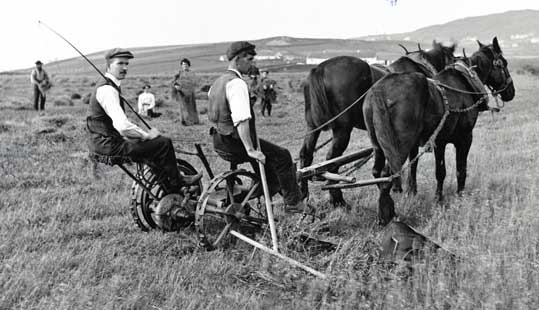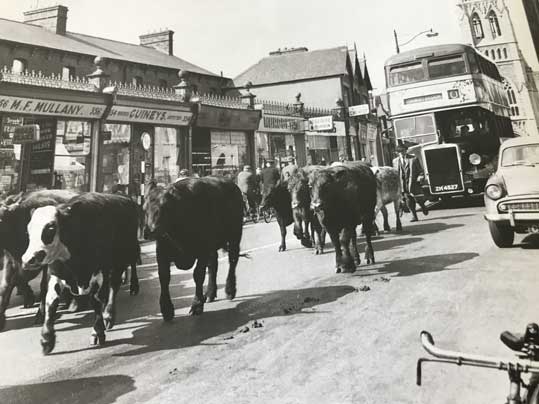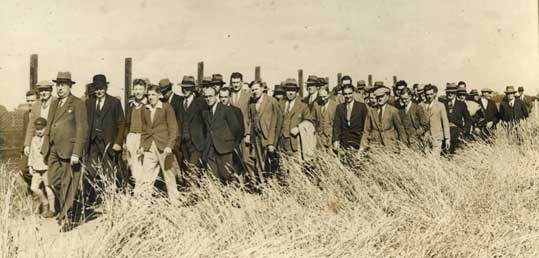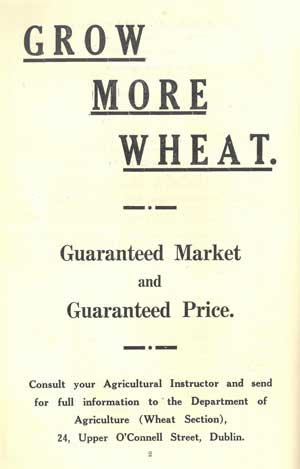Cultivating a return: tillage farming, food security and the lessons of the early twentieth century
Published in Features, Issue 5 (September/October 2022), Volume 30By Mícheál Ó Fathartaigh
Over the past few months, the Irish minister for agriculture, Charlie McConalogue, has suggested on several occasions that Irish farmers could and should be growing more crops. Theoretically, he is right. Securing sustainable food supplies for the population has never been more important. Since the mid-twentieth century, Irish agriculture has gradually shifted away from mixed farming towards monocultural farming, with Irish farmers increasingly specialising in singular enterprises, particularly livestock and dairy farming. This made financial sense, but it has also made Ireland precariously reliant on imports of other agricultural products, especially crops such as wheat, and also fruit and vegetables. This was broadly acceptable in settled economic circumstances, but the acute turbulence engendered by Brexit, the energy crisis and the Ukrainian conflict has exposed Ireland’s dependence on imports. With pressure on international food supplies only likely to intensify as the number of people in the world continues to multiply and the need to curb the carbon emissions associated with global commerce becomes ever more of an emergency, Minister McConalogue knows that Irish farmers must respond. However, will they be able to respond? The history of the first half of the twentieth century indicates that they will, but only if lessons are learned from it.

Above: Harvest time in Malin Head, Co. Donegal, during the First World War, when tillage farming was first promoted. (NLI)
Three times in the first half of the twentieth century Irish farmers answered a governmental call to diversify into tillage, and in a big way: in the 1910s, 1930s and 1940s. First, during First World War, when the British government attempted to guarantee its domestic food sources in order to defeat the Central Powers. Second, during the protectionist era and the Economic War, when the Irish government sought to make the Free State self-sufficient. Third, during the Second World War, when the Irish government, neutral and in splendid isolation for real, could no longer count on food imports whether it wanted to or not.

Above: Phibsborough, Dublin, in the 1950s. Even in an urban setting cattle dominated Irish life. (G.A. Duncan)
First World War
Between 1914 and 1915 Irish farmers responded to the government’s entreaty to grow more crops by repurposing 83,000 acres for tillage and producing 6% more tillage products. The state-supported price for tillage products was a factor in this, and Irish farms might not have been as configured around livestock as they are now. However, this is nonetheless impressive. It was also a year before Irish farmers were obliged to divert a proportion of their land to crop cultivation under the compulsory tillage orders of the Defence of the Realm Act. In this instance and subsequently in the 1930s and 1940s a significant reason for the success was the role played by the agricultural advisory service and its excellent relationship with Irish farmers.
Generally speaking, Ireland is not suited to arable farming. It is practised widely in particular counties like Wexford and Kildare, but Irish soils and climatic conditions dictate, in many ways, an overall livestock orientation for Irish agriculture. Therefore, diversification into any kind of tillage farming often takes a remarkable effort. Farmers have to ‘upskill’ so as to recast themselves as tillage farmers. A popular presumption is that livestock farmers can simply segue into tillage farming. This is akin to presuming, though, that an electrician could easily switch to plumbing if the prevailing imperative demanded. In reality, during the 1910s, 1930s and 1940s Irish farmers had to have substantial help to become tillage farmers. This necessitated extensive knowledge transfer and, as a consequence, the effective redeployment of the national agricultural advisory service.
National agricultural advisory service
Founded in the early 1900s through the endeavour of Horace Plunkett, the advisory service was attached to the Department of Agriculture and Technical Instruction (and, latterly, following partition, to its successors in Dublin and Belfast) and to the county councils. It was organised on a county basis, with each county having its own team of instructors. The advisory service was given a huge mandate: to help Irish farmers to farm better, a challenge made all the more massive because of the disparity in the ratio of farmers to instructors. This was especially the case in the 1910s, when there were approximately 850,000 farmers but two-thirds of counties had failed to appoint even a basic complement of two general instructors. Despite this, the advisory service hit the ground running and managed to build an immediate rapport with progressive farmers, facilitated by the quick financial gains that farmers had realised from implementing the new techniques that the instructors taught.
By the First World War, this was enough of a dynamic through which livestock and dairy farmers could be transitioned to tillage; and only through it were they equipped with the skills essential to become tillage farmers. Without the advisory service and its relationship with Irish farmers, the first tillage reboot, compulsory or otherwise, subsidised or not, would not have succeeded.
Second tillage drive, 1930s
In addition to helping Irish farmers to upskill, instructors also had to convince them of the requirement for tillage farming. Regardless of the compulsion and subsidisation behind tillage, livestock and dairy farming continued to be far more attractive, with bumper prices on the market acting as a major disincentive to diversify. Persuasion became even more salient during the second tillage drive of the 1930s. After the First World War, Irish farmers had moved away sharply from tillage again and so tillage farming had to be developed from yet another low base in the 1930s. Moreover, compulsion was not used this time, and the guaranteed price for a barrel of wheat in 1933 was 25 shillings, whereas in 1918 it had been 41 shillings. Nonetheless, the area under wheat in the Irish Free State grew from 22,239 acres in 1932 to 254,519 acres in 1938, an increase of a whopping 1,044%.
Second World War
Evangelisation by the advisory service, complemented by the esteem for instructors in rural Ireland was an even more decisive factor behind the success of the tillage drive of the 1930s than the 1910s. Decisively in turn, it also increased efforts to meet the challenge brought about by the Second World War and the renewal of a compulsory tillage regime. Initially during the war, the guaranteed price for wheat was 35 shillings per barrel; 6 shillings less than during the previous war, but between 1940 and 1945 Irish farmers still produced 111% more wheat. They also produced 77% more barley, 62% more oats, 18% more potatoes and 111% more sugar beet.
Just as a river rerouted will gradually revert to its easiest course, following the second cessation of compulsory tillage in 1948, most Irish farmers again returned to livestock and dairy farming and, furthermore, to ever greater specialisation centred around these two enterprises chiefly. From the mid-twentieth century, Irish agriculture became more commercial, too, with Irish farms increasingly functioning as business enterprises rather than as the means for a subsistence livelihood. Greater specialisation underpinned this, particularly after Ireland joined the European Economic Community in 1973 and Irish farms had to compete with their more streamlined continental counterparts in the new common market.

Above: A visit by Wexford farmers to Albert Agricultural College, Glasnevin (today part of Dublin City University campus), 18 August 1938. (Laura Connolly)
Prospects for tillage today?
By 2020, 96% of specialist farms in Ireland were livestock or dairy farms (74,159 beef farms, 17,435 sheep farms and 15,319 dairy farms) and only 4% were tillage farms (4,567). This is a much lower base of tillage farming than at any point in the first half of the twentieth century. In 1915, for example, 15% of Irish farmland was used for arable farming. Nonetheless, informed by the three precedents of the first half of the twentieth century, a contemporary tillage drive is practicable. The key lesson of the three precedents, though, is that Irish farmers must be helped professionally—and not just compelled financially or, indeed, legislatively.
Helping them professionally should be more straightforward than it was in the 1910s, 1930s and 1940s, too. The ratio of farmers to advisors (as instructors are called today) is much more satisfactory. In 2020, there were 135,037 farms in the Irish state and approximately 400 public and private advisors. In addition, Irish farmers are far better educated. The ability of advisors to transfer knowledge successfully to farmers has always been predicated on the reciprocal ability of farmers to properly receive and, consequently, to utilise this knowledge. In the first half of the twentieth century, Irish farmers were not generally in a position to engage fully with the advisory service because they often had only an elementary standard education and, moreover, typically no formal vocational education. Despite this, three tremendous transitions to tillage, albeit temporary, were achieved. Today, a growing majority of Irish farmers have third-level agricultural qualifications, such as the Certificate in Farming, or ‘Green Cert’, which was first introduced in 1982, and this represents a very propitious basis for knowledge transfer.
If Minister McConalogue is serious in his desire to see Irish agriculture diversify away from livestock and dairy farming and towards a larger measure of tillage farming, then he should heed the three precedents of the first half of the twentieth century and he should empower the advisory service, working with Irish farmers, to assume the lead, farm by farm.
Mícheál Ó Fathartaigh is a member of the Social Sciences Research Centre at the University of Galway and lectures in history at Dublin Business School.
Further reading
M.E. Daly, The first Department: a history of the Department of Agriculture (Dublin, 2000).
D. O’Brien, The Dublin cattle market’s decline, 1955–73 (Dublin, 2021).
M. Ó Fathartaigh, Developing rural Ireland: a history of the Irish Agricultural Advisory Services (Dublin, 2021).
P. Rouse, Ireland’s own soil: government and agriculture in Ireland, 1945–65 (Dublin, 2000).

















